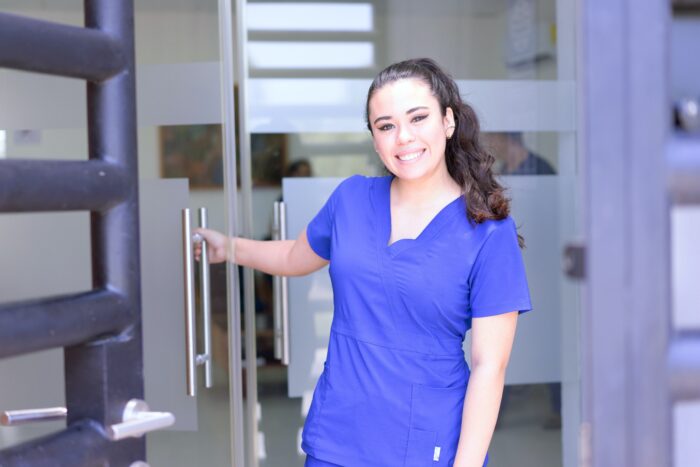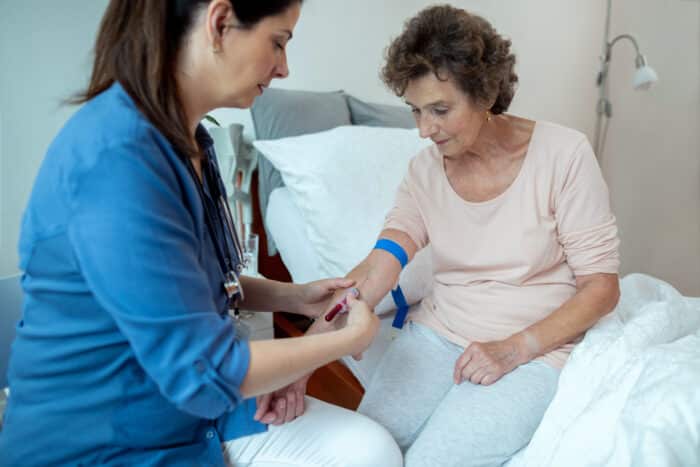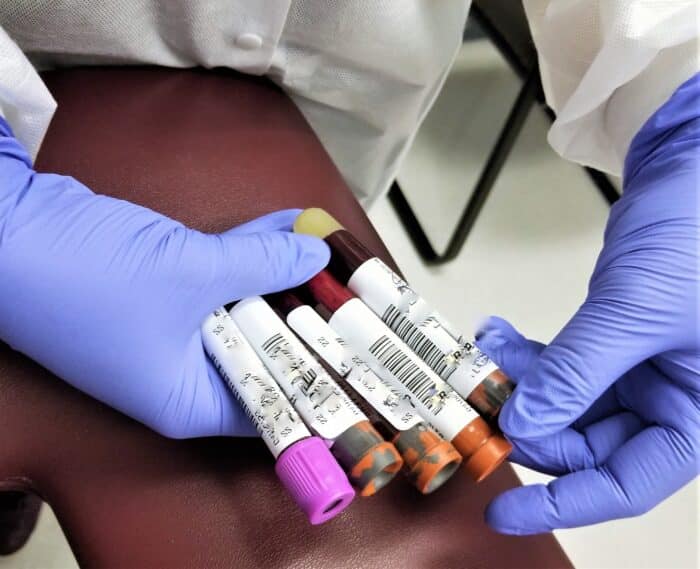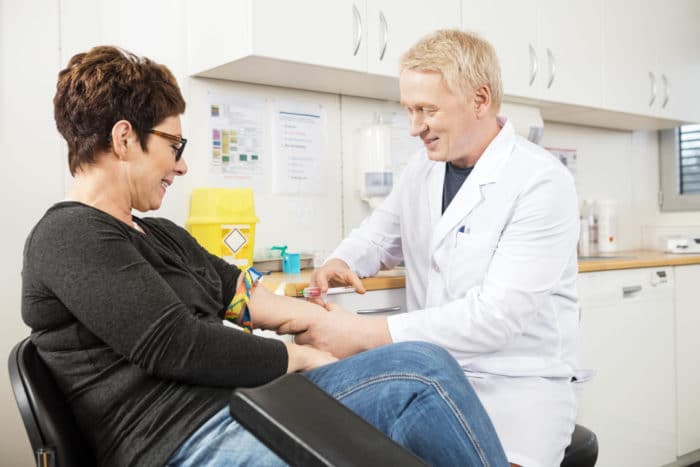Have you ever wondered what a phlebotomist does during a typical workday?
Do their responsibilities only involve drawing blood?
And is phlebotomy as a career worth it?
If you are interested in becoming a phlebotomist, or if you’re here to know more about these unsung heroes, these questions must have crossed your mind.
In this article, we aim to answer all of such questions and more. We will also uncover what fields you can transition to as a certified phlebotomist.
So let’s dive right in.
What Does a Day in the Life of a Phlebotomist Look Like?
You might want to know what the daily routine of a phlebotomist looks like, before diving headfirst into becoming one.
Let us help you with that.
Here is a step-by-step run-through of a typical day for a phlebotomist, starting to end. One important thing to note here is that this schedule is highly dependent on a variety of factors, such as the type of healthcare facility, working hours, and so on.
So from the moment phlebotomists step into their workplace or healthcare setting, whether it’s a hospital, a clinic, or a blood donation center, phlebotomists have to handle different tasks and even multitask throughout the day.
Also read: What is a Phlebotomist?
Morning Preparation/Set-up:
The day typically begins with the phlebotomist gearing up for their shift. After they enter and settle in, they check their schedule, gather their equipment – including needles, collection tubes, tourniquets, gloves, and disinfectants – and ensure everything is sterilized and ready for use.
Another thing to note is that for phlebotomists, attention to detail is important, and hence they are required to always double-check patient information, sample labels, and requisitions to guarantee accurate specimen collection.
Greeting Patients:
As patients start to arrive, the phlebotomist greets them answers any queries they have, and comforts them. They also explain the procedure and address any concerns or anxieties.
Building trust is important to maintain a comfortable atmosphere, especially since many patients might be nervous about needles or the process itself.
Performing Venipuntures:
Phlebotomists then start with the blood drawing procedure. They skillfully locate suitable veins for blood collection. They need to be proficient enough to ensure minimal discomfort and successful sample retrieval.
The phlebotomist then carefully prepares the site, secures a tourniquet to enhance vein visibility, and uses a gentle touch to insert the needle.
Sample Collection and Storage:
Each collection tube needs to be accurately labeled and correctly stored. The phlebotomist carefully fills the tubes in the correct order to avoid cross-contamination and maintains strict labeling procedures to ensure accurate identification.
Providing Comfort to Patients:
Throughout the process, the phlebotomist has to be empathetic and show compassion for patients’ feelings. They understand that for many patients, blood draws can be anxiety-inducing.
They offer words of encouragement, engage in conversation to distract from the procedure, and provide a reassuring presence to alleviate discomfort.
Maintaining Cleanliness and Safety:
Infection control and safety are some of the most important aspects of performing phlebotomy. The phlebotomist adheres to strict infection control protocols, including proper hand hygiene, glove usage, and disposal of hazardous materials. They ensure the cleanliness of the collection site and promptly address any accidental spills or mishaps.
Accurate Documentation:
After each successful blood draw, phlebotomists have to document each sample. The phlebotomist accurately labels each sample, notes any special instructions or considerations, and ensures the paperwork is in order.
They also communicate effectively with other healthcare professionals, passing on crucial information related to the collected samples and the patient’s well-being.
End of Shift/Closing Time:
As the day ends, the phlebotomist sanitizes their workspace, restocks supplies, and prepares for the next day’s endeavors.
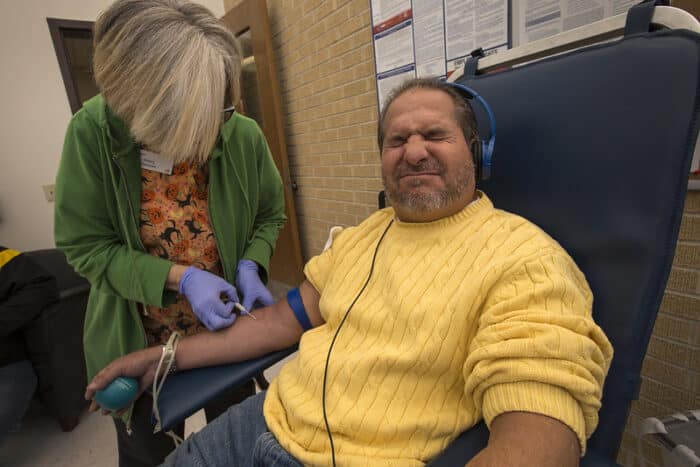
Do You Want To Become a Phlebotomist? Check Out Free Phlebotomist Masterclass!
In our masterclass you learn:
- How to be a Phlebotomist faster…in just 2 months!
- Avoid student debt & driving to classes
- #1 thing employers want from Phlebotomists
- How to stand-apart & get a university certificate for a strong resume
Phlebotomist Career Scope
Now that you know what a day in a phlebotomist’s life looks like, the next thing you might be wondering is what the scope of this career looks like.
Let us explore.
When it comes to how much phlebotomists earn, according to the U.S. Bureau of Labor Statistics, the average mean wage of phlebotomists was around $37,380.
However, it is important to emphasize that these figures are subject to changes, simply because the salary is dependent on a variety of factors such as job location, experience, and certifications.
As for the job outlook, the BLS also reported a significantly positive report on that front. It was stated that the expected job outlook for the years 2021-31 is expected to rise by 10%, which is much faster than the national average for other professions.
Career Paths You Can Choose After Becoming a Phlebotomist
If you’re a certified phlebotomist with experience looking for a career switch, or if you’re interested in the career and want to know other options you can choose after you become one, we’ve got you covered.
Here is a list of more career paths you can choose from after working as a phlebotomist:
- Medical Lab Technician: You can become a medical lab technician or technologist with additional education. These experts do more complex tests, analyze results, and help diagnose and treat illnesses.
- Medical Assistant: Your phlebotomy skills can become useful for a medical assistant job. They do both office work and help with patients in places like clinics. Their duties include checking vital signs, getting patient history, and assisting doctors, among others.
- Specialized Phlebotomist: You can specialize in things like drawing blood from kids, older people, or people not staying in the hospital. You’ll need more training to work with these different groups.
- Phlebotomy Instructor: If you know a lot about phlebotomy, you could teach new phlebotomists. You’d make lessons and show them how to do the job well.
- Clinical Research Coordinator: Help with research studies in medical settings. Your skill in collecting blood can help with getting samples for research.
- Pathology Assistant: With more learning, you can assist pathologists. Your experience with blood collection can be a big help.
- Healthcare Administrator: After getting experience as a phlebotomist for a while, you have the option of becoming a leader in healthcare. You could manage phlebotomists, make schedules, and make sure patients get good care.
- Nurse: If you want to do more for patients, you could also become a nurse. Your phlebotomy background can help you learn nursing faster.
Also read: How to Become a Phlebotomist
Conclusion
Phlebotomists are known as the backbone of the healthcare industry, and this article was an insight into what a day in their life looks like.
A career in phlebotomy is not only rewarding on its own but can also be considered as a base for many other careers that were mentioned above.
Additional Resources:
- How Long Does it Take to Become a Phlebotomist
- Phlebotomist Salary
- Phlebotomist Requirements
- Phlebotomist Skills
- Phlebotomist Programs
- Ultimate Phlebotomist Resume Guide – Phlebotomy Job
- Phlebotomist Job Description
- Can A Phlebotomist Start IVs?
- Phlebotomist Duties
- What is the Difference Between a Licensed Phlebotomist and Certified Phlebotomist?
- What Do You Need To Be a Phlebotomist?
- Pros and Cons of Being a Phlebotomist
- Phlebotomy Externship
- Mobile Phlebotomist
- How Long Does it Take to Get a Phlebotomy Certification?
- What are the Different Types of Phlebotomy Certifications?
- Top Places That Hire Phlebotomy Techs
- Phlebotomist vs CNA
- Is a Phlebotomist a Nurse?
- Phlebotomy Course
- Phlebotomist School
- Online Phlebotomy Classes
- Phlebotomy Classes Cost
- Phlebotomy Interview Questions
- Phlebotomist Career
- 4-Week Phlebotomy Classes Online
- Venipuncture vs. Phlebotomy: Differences
Related Articles
-
How to Be Successful in College in 2022 – 7 Simple Tips to Succeed
-
How Do Scholarships Work? Read This First…Truth is Shocking
-
7 Best College Majors 2024: What Should I Major In?
-
How to Choose a College – 10 Things You Must Consider in 2024
-
Why Go to College? Top 13 Benefits for Adult Students in 2022
-
Top 5 Best Alternatives to Community College for 2024
